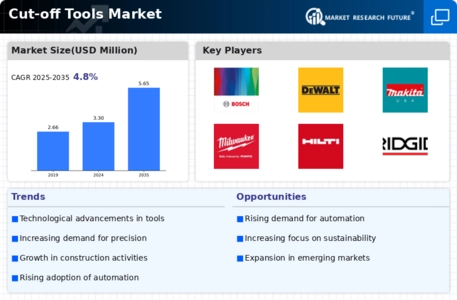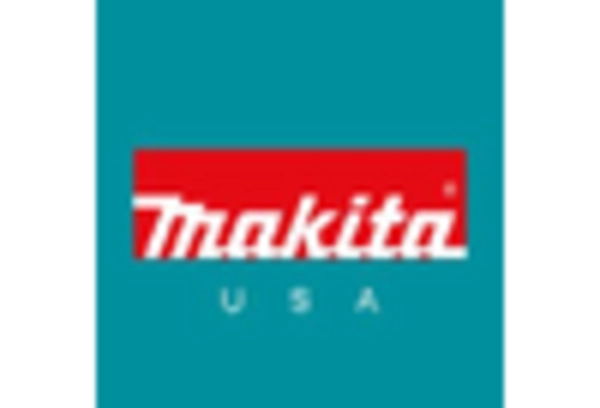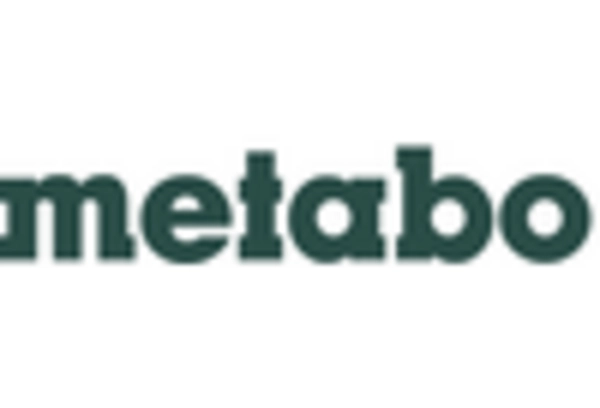Growing DIY Culture
The rise of the DIY culture is significantly influencing the cut-off tools market. As more individuals engage in home improvement projects, the demand for user-friendly and efficient cut-off tools is increasing. This trend is particularly pronounced among millennials and Gen Z, who are more inclined to undertake DIY tasks. Retailers are responding by expanding their offerings of cut-off tools, catering to both novice and experienced users. The market is projected to grow as manufacturers develop tools that are not only effective but also easy to use, appealing to this burgeoning demographic. Additionally, the availability of online tutorials and resources is likely to further encourage DIY enthusiasts to invest in quality cut-off tools.
Technological Innovations
Technological advancements play a crucial role in shaping the cut-off tools market. Innovations such as improved blade materials, enhanced motor efficiency, and smart technology integration are transforming the capabilities of cut-off tools. For instance, the introduction of diamond blades has significantly increased cutting efficiency and durability, appealing to both professional and DIY users. Furthermore, the integration of smart features, such as automatic speed adjustments and safety sensors, is likely to attract a broader customer base. As these technologies evolve, they not only improve performance but also reduce operational costs, making them more appealing to end-users. The market is expected to grow as manufacturers continue to invest in research and development to create cutting-edge solutions.
Expansion of Automotive Industry
The automotive industry is undergoing rapid transformation, which is positively impacting the cut-off tools market. As manufacturers adopt advanced manufacturing techniques and materials, the need for precise cutting tools is becoming more pronounced. The shift towards electric vehicles and lightweight materials necessitates the use of specialized cut-off tools that can handle new materials effectively. This trend is expected to drive growth in the cut-off tools market, as automotive manufacturers seek tools that enhance efficiency and precision in production processes. Furthermore, the increasing focus on sustainability within the automotive sector is likely to encourage the development of eco-friendly cut-off tools, aligning with broader industry goals.
Rising Demand in Construction Sector
The construction sector is experiencing a notable surge in demand for cut-off tools, driven by ongoing infrastructure projects and urban development initiatives. As cities expand and new buildings emerge, the need for efficient cutting solutions becomes paramount. The cut-off tools market is projected to witness a compound annual growth rate of approximately 5.2% over the next few years, reflecting the increasing reliance on these tools for precision and efficiency in construction tasks. This trend is further supported by the growing emphasis on safety and quality standards in construction, which necessitates the use of advanced cut-off tools. Consequently, manufacturers are innovating to meet these demands, thereby enhancing their market presence and competitiveness.
Increased Focus on Safety Regulations
Safety regulations are becoming increasingly stringent across various industries, which is positively impacting the cut-off tools market. As organizations prioritize worker safety, the demand for tools that comply with safety standards is on the rise. This trend is particularly evident in sectors such as construction, manufacturing, and metalworking, where the risk of accidents is higher. The market is responding by developing cut-off tools that incorporate safety features, such as blade guards and anti-vibration technology. According to industry reports, compliance with safety regulations can enhance productivity and reduce liability costs, further driving the adoption of advanced cut-off tools. As a result, manufacturers are likely to focus on creating tools that not only meet but exceed safety standards.


















Leave a Comment